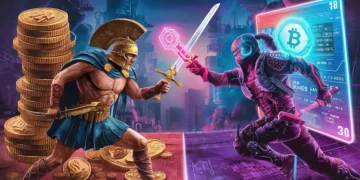
TL;DR
Full Story
To get their first million or so users, PayPal used a very simple, yet very effective tactic:
They paid them!
PayPal used to literally pay new customers $10 to use their product.
(Which led to millions of people using it for eBay purchases, and then an acquisition from eBay themselves for $1.5 Billion).
While this tactic has been used a ton since then (think: credit card companies or banks paying you a ‘sign up’ bonus), Web3 is uniquely positioned to take advantage of it.
For example, Magic Square – who call themselves ‘the first Web3 app store’ – just announced that they would be committing $66 million worth of their native SQR token for grants to projects listed on their platform.
Here’s why this is cool:
For one, providing grants to projects who plan to be listed on the Magic Square platform is a huge incentive for developers to start building.
At the same time, it helps Magic Square become less of a ghost town, and more of ‘the place to go’ for anyone looking to explore Web3 apps.
But the most important piece to this is the aligned incentives.
If a developer creates a killer app, and the only place to find it is through Magic Square, you’d expect millions of people to visit Magic Square.
The more hype around the platform → the higher the SQR token is likely to grow → the higher the value of SQR, the greater benefit to those companies who received grants.
That’s all a long way of saying:
Anything attracts more builders, where the builders themselves can be rewarded — we’re all for it.
(If only we could code).





















































































get clomiphene online get cheap clomiphene without rx where buy generic clomid without dr prescription where can i get generic clomid no prescription can i purchase generic clomid pills how to buy clomiphene without prescription where buy clomiphene price
This is the type of delivery I recoup helpful.
The thoroughness in this break down is noteworthy.
order zithromax pills – generic tindamax 300mg flagyl 400mg generic
rybelsus usa – how to buy rybelsus order periactin 4mg without prescription
domperidone pill – cheap tetracycline buy cyclobenzaprine 15mg sale
purchase inderal without prescription – order methotrexate 10mg sale order methotrexate 2.5mg generic
amoxil cheap – diovan tablet buy generic combivent over the counter
cheap zithromax – nebivolol 20mg brand bystolic 20mg pills
buy augmentin 625mg pills – atbioinfo ampicillin drug
buy cheap generic nexium – nexiumtous nexium uk
order coumadin pills – https://coumamide.com/ buy losartan online cheap
order meloxicam 7.5mg online – relieve pain buy mobic 15mg pills
prednisone for sale – apreplson.com deltasone 20mg drug
cheap erectile dysfunction pill – fastedtotake cheap erectile dysfunction pills
buy amoxil sale – https://combamoxi.com/ order amoxicillin
buy diflucan 100mg pill – fluconazole 100mg pill order fluconazole pill
cenforce online buy – on this site cenforce 100mg sale
cialis soft – cialis from canadian pharmacy registerd whats the max safe dose of tadalafil xtenda for a healthy man
ranitidine 150mg us – https://aranitidine.com/ zantac medication
cialis 5mg daily – cialis free trial voucher 2018 cialis at canadian pharmacy
I couldn’t hold back commenting. Well written! https://gnolvade.com/
viagra sale china – on this site sildenafil tablets 100mg
I couldn’t hold back commenting. Warmly written! https://ursxdol.com/synthroid-available-online/
This is the description of glad I enjoy reading. zithromax price
The depth in this tune is exceptional. https://prohnrg.com/product/rosuvastatin-for-sale/
More posts like this would create the online space more useful. https://ondactone.com/spironolactone/
This is a topic which is forthcoming to my verve… Many thanks! Quite where can I lay one’s hands on the contact details due to the fact that questions?
medex generic
The reconditeness in this ruined is exceptional. https://maps.google.com.gh/url?q=http://https://doselect.com/@decab16353abf074be022fa5f
This is a topic which is virtually to my callousness… Myriad thanks! Unerringly where can I notice the acquaintance details an eye to questions? http://zgyhsj.com/space-uid-977930.html
buy forxiga 10 mg for sale – https://janozin.com/ order forxiga generic
orlistat online buy – https://asacostat.com/ order generic xenical 60mg
More posts like this would add up to the online space more useful. https://lzdsxxb.com/home.php?mod=space&uid=5112498